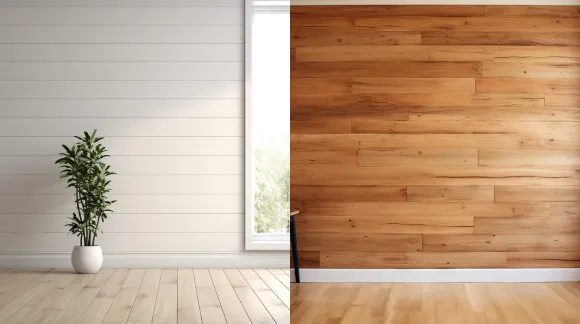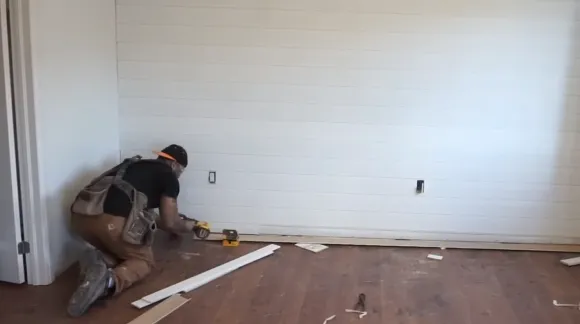Last Updated on September 16, 2023
Shiplap and plain wood plank are two popular options for adding texture and interest to interior walls and floors. Both materials offer unique aesthetics, making them suitable for various settings and decor styles. However, these options differ in their panel orientation, joint styles, aesthetic appeal, and more.
Shiplap is defined by its horizontal panel orientation, but plain wood plank typically features long, narrow boards placed side by side. Also, Shiplap features an overlapping joint system with an “L” or rabbet shape cut, whereas plain wood planks are stacked with no overlapping joint system.
Our goal in this blog article is to clarify the differences between shiplap and plain wood planks so that you can decide which is best for your next home renovation. So, keep reading for an in-depth discussion.
Shiplap vs Plain Wood Plank: Key Differences for Your Home Design

When considering the differences between shiplap siding and plain wood planks, here are some points:
- Panel orientation
- Joint style
- Aesthetic style
- Installation purpose
- Installation process
- Panel spacing
- Architectural fit
- Maintenance
1. Panel Orientation
The horizontal placement of the shiplap and its overlapping grooves have made it a popular choice in recent years. It’s a professional yet casual look that can be used indoors and outdoors.
As opposed to this, plain wood plank flooring offers a more traditional and less busy appearance. While it doesn’t offer the same seamless look as shiplap, it creates a solid surface that can withstand daily wear and tear.
2. Joint Style
Shiplap has an overlapping joint system known as an “L” or rabbet shape, allowing each board to fit snugly over or under the adjacent one. This creates a uniform appearance with distinctive horizontal lines. The overlapping design provides added durability and stability to your walls, keeping gaps and movement at bay.
Conversely, plain wood plank walls lack this overlapping joint system. Instead, individual wooden boards are placed side by side or stacked with visible seams between each plank.
3. Aesthetic Style
Shiplap creates a cozy, cottage-like ambiance in a room with its rustic and coastal aesthetic. The horizontal lines of this popular wall paneling contribute to its character and charm.
This is often associated with beach cottages and farmhouse decor, evoking warmth and relaxation. Its natural wood texture adds a touch of authenticity and nostalgia to any space.
Alternatively, plain wood planks offer a more versatile aesthetic that can be easily customized to match various decor styles. These planks adapt seamlessly to rustic and modern interior design themes, whether stained or painted. Their simplicity allows endless possibilities in creating a unique and personalized look.
4. Installation Purpose
Shiplap is a weather-resistant exterior wall covering, but now it’s trendy and stylish. It adds visual interest to walls and makes a statement with its unique design.
Meanwhile, plain wood planks are more functional and are typically used for flooring. However, they can also be used on walls to create a durable and attractive surface.
5. Installation Process
When considering shiplap, attaching each board to the wall is relatively straightforward. You’ll use nails or screws to secure them through the overlapping joints. This design hides imperfections in the wall and ensures a consistent gap between boards for a clean look.
However, installing plain wood planks can be slightly more challenging. Each board needs to be individually nailed or secured to the wall, requiring precision and attention to detail. Achieving an even alignment and gap between planks can be trickier, especially if your wall has irregularities.
6. Panel Spacing
When installing shiplap, deliberate spacing between the boards is crucial. Aim for a gap of around 1/8 inch, as this creates those characteristic horizontal gaps that add to its unique charm. These gaps are part of the shiplap’s design and don’t require any additional sealing or caulking.
Alternatively, plain wood plank flooring should be installed tightly together to create a seamless and smooth surface with no visible gaps between the boards.
However, you may encounter visible gaps or seams between boards with plain wood plank walls. If you want a more finished look, consider using spacers or filling these seams with caulk to create an even surface.
7. Maintenance
Regular cleaning will be a breeze if you choose shiplap walls because of their smooth surface and overlapping joints. The clean lines and uniformity of the shiplap make it easier to wipe away dust and dirt, ensuring that your walls always look fresh.
With the overlapping joints, there are fewer gaps for debris to accumulate, saving you time and effort in maintenance. Also, the durability of the shiplap means that it can withstand more rigorous cleaning methods if necessary.
On the other hand, plain wood plank walls may require more effort to maintain. The visible seams between boards can trap dust and debris, making cleaning more challenging. Regular vacuuming or a soft brush can help keep these walls pristine.
What is the average cost of installing plain wooden planks?
When considering wood flooring installation costs, you can expect to pay between $6 and $12 per square foot. This price includes materials and labor, with materials accounting for around $3 to $7 per square foot and labor costing approximately $3 to $5 per square foot.
The specific cost within this range will depend on various factors such as the wood’s quality, the installation’s complexity, and any additional customization or finishes required.
What is the average price of installing a shiplap?

The shiplap installation cost varies depending on the type of wood you choose. Generally, materials for shiplap range from $2 to $7 per square foot, while labor costs fall between $1 and $4 per square foot. This brings the total cost to approximately $3 to $11 per square foot installed.
If you’re considering using shiplap for exterior siding, be prepared to pay around $3 to $8 per square foot installed. Remember that these figures are averages and may vary based on location and specific project requirements.
What is the average length of plain wood planks?
Nowadays, the average length of most plain wood planks is only 2′ to 3′ long, making it quite challenging to come across floorboards that exceed 6′ in length. These shorter planks are more readily available and easier to manage during installation.
But, if you desire longer lengths for your project, be prepared for additional costs and a longer waiting period. Longer planks can create a more seamless and visually appealing look, as they minimize the number of visible joints on the surface.
Shiplap or Plain Wood Planks: Choose Your Material Carefully
Choosing the right material for your interior walls or floors can significantly impact the overall look and feel of your home. While shiplap and plain wood plank share similarities, the installation process, panel spacing, architectural fit, and maintenance requirements differ.
Whether you’re aiming for a rustic farmhouse or a modern look, consider the nuances of each material to ensure that it fits your decor style and needs. Hopefully, this article helped you understand the difference between shiplap and plain wood plank so you can decide wisely when renovating your house.



![MDF vs Wood Shiplap: 8 Differences [Exposed]](https://handyworkshop.com/wp-content/uploads/2023/09/MDF-vs-Wood-Shiplap.webp)